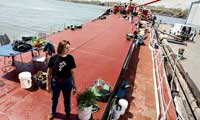
Photo: Emily Berl for The New York Times
There are over five hundred miles of waterfront in New York harbor. The Mary A. Whalen only needs around 200 feet of it to tie up, yet for the last six years, the historic tanker and PortSide New York, the non-profit educational organization based on the ship, have been without a permanent home. The condition has reached a crisis. If a new home for the historic tanker is not found soon, she may she scrapped. The New York Times published a front page article this morning (front page on their web site, and the first page of the Metropolitan section in their print edition) on the struggle to find a home for the Mary A. Whalen. Definately worth reading.
No City for Old Tankers
Some ships run into icebergs and become 3-D movie extravaganzas; others disappear silently into the abyss of paperwork.
Carolina Salguero, 51, bought the 613-ton ship for her nonprofit organization, PortSide NewYork, in 2006 for $16,500, with plans to serve visitors and the companies working in the harbor. She envisioned a future of educational exhibitions and cultural events, as well as weddings and other fund-raising activities. A local opera company staged Puccini’s “Il Tabarro” for large crowds in 2007, but never again.
Now the Mary Whalen is homeless, and PortSide is running out of money, unable to afford the $5,000 a month it costs to keep the ship idle. Unless the organization finds a new berth or a stream of cash in the next few weeks, Ms. Salguero said, she will have to disband it and give up the 74-year-old vessel, probably consigning it to the scrap heap.
“It’d be a barren and sorrier harbor without the Mary Whalen,” said Roland Lewis, president of the Metropolitan Waterfront Alliance, a consortium of organizations working on the shoreline.
“It’s a living artifact of New York’s maritime history, as important as a painting in a museum or anything that tells us who we are and how we got here,” Mr. Lewis said. “And you can get inside it, unlike a painting. It’s right in the water where it lived and worked.”
